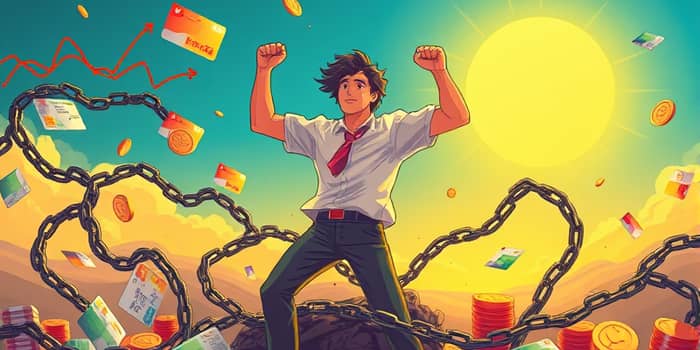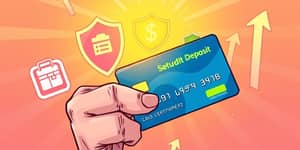Credit card debt can feel overwhelming, but with the right knowledge and determination, you can regain control of your financial future.
Understanding the Current Debt Landscape
In Q1 2025 the national average credit card debt among borrowers with unpaid balances reached $7,321, reflecting wider economic shifts. Though this marks a 5.8% increase from the prior year, total balances dipped slightly from their all-time high of $1.21 trillion in Q4 2024.
Compared to early 2022, when average balances stood at $5,026, the 26% climb highlights how rising living costs and interest rates have impacted everyday spending habits. Delinquency rates, while still below historic peaks, have risen quarter over quarter since 2021, underscoring ongoing stress for many American families.
Driving Forces Behind Rising Balances
Two primary factors stand out in the surge of credit card debt: inflationary pressures and elevated borrowing costs. As daily expenses for groceries, housing, and utilities rise, more households turn to credit cards to make ends meet.
Emergency expenses—such as unexpected medical bills, home repairs, and car maintenance—often force families to rely on plastic when no other options are available. These challenges combine to create persistent financial pressure from inflation that prolongs debt cycles and strains budgets.
Demographic Patterns: Who Is Most Affected?
Ownership of credit cards varies widely across generations, and so does the likelihood of carrying a balance. Nearly half of all cardholders—48%—report carrying a balance month to month, up from 39% in late 2021. This statistic reveals that many are using credit for essential bills rather than discretionary spending.
This data shows that older generations hold cards more frequently, while younger cohorts are increasingly reliant on credit to manage day-to-day expenses. Regardless of age, nearly three-quarters of Americans have at least one personal credit card, highlighting the ubiquity of this financial tool.
Proven Strategies to Pay Down Debt
Choosing the right payoff method is the first step toward a rapid personal finance turnaround. Two approaches dominate smart debt reduction plans:
- Snowball Method: Prioritize paying off the smallest balance first while maintaining minimum payments on all others. This approach builds confidence through quick victories and can create momentum.
- Avalanche Method: Target the card with the highest interest rate first, reducing your long-term interest burden. Although initial progress may feel slower, this technique saves money over time.
Regardless of the method, consistency is crucial. Adjust payment amounts as balances shrink and celebrate milestones to stay motivated.
Structural and Negotiation Tools
If traditional payoff plans seem out of reach, structural changes can offer relief. Consider these options:
- Balance Transfer: Move high-interest balances to a card offering a promotional low or 0% APR, then focus payments to eliminate the debt before rates revert.
- Personal Loan Consolidation: Combine multiple credit cards into a single loan with a potentially lower fixed rate, simplifying payments and timelines.
- Home Equity Loan or Line of Credit: Leverage home equity for lower rates, but proceed with caution—your home serves as collateral.
- Contacting Lenders Directly: Request hardship assistance, negotiate lower interest rates, or explore customized payment plans during difficult times.
Best Practices to Stay Debt-Free
Once you tackle existing balances, adopting healthy financial habits will prevent debt from creeping back into your life. Implement the following practices:
- Pay more than the minimum payment whenever possible to reduce principal faster and minimize interest charges.
- Review and adjust spending categories to ensure your budget aligns with your debt reduction goals.
- Establish an emergency fund to shore up unexpected costs and avoid new debt accumulation.
- Set realistic budgets and savings targets as part of a comprehensive financial stability roadmap for the future.
- Consult certified credit counselors or nonprofit agencies for professional advice if you feel overwhelmed.
The Broader Impact and Long-Term Outlook
Persistent credit card debt erodes household wealth and dampens consumer spending, which in turn can slow economic growth. Rising delinquencies may pose risks to credit markets, although current rates are still far below those seen during past recessions.
Maintaining healthy credit habits benefits individuals and the wider economy. By reducing balances and avoiding missed payments, consumers contribute to a robust financial ecosystem, lowering the probability of widespread credit stress.
Facing credit card debt can be challenging, but by arming yourself with data, proven methods, and disciplined habits, you can achieve lasting freedom from high-interest obligations. Remember that every payment brings you one step closer to relief and a brighter financial future.
Start today by choosing the approach that fits your personality, committing to a clear plan, and celebrating progress along the way. With persistence and the right strategies, you can transform debt from a burden into a conquered milestone.
References
- https://www.lendingtree.com/credit-cards/study/credit-card-debt-statistics/
- https://www.stlouisfed.org/on-the-economy/2025/may/broad-continuing-rise-delinquent-us-credit-card-debt-revisited
- https://www.newyorkfed.org/microeconomics/hhdc
- https://www.bankrate.com/credit-cards/news/credit-card-debt-report/
- https://www.nasdaq.com/articles/average-credit-card-debt-more-quarter-what-means-americans-wallets-and-economy
- https://www.bairdwealth.com/insights/wealth-management-perspectives/2022/08/5-strategies-for-paying-off-credit-card-debt/
- https://www.incharge.org/understanding-debt/credit-card/how-to-manage-credit-card-debt/
- https://tradingeconomics.com/united-states/debt-balance-credit-cards










